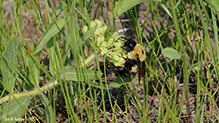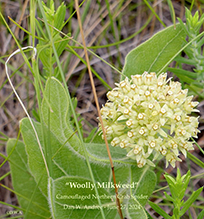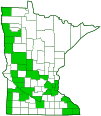woolly milkweed
(Asclepias lanuginosa)
Conservation • Description • Habitat • Ecology • Use • Distribution • Taxonomy
|
|
||||||||||||||
Description |
Woolly milkweed is a 6″ to 12″ tall, weekly erect, perennial forb that rises on a single stem. The leaves and stems contain a milky juice. The stem is covered with long, soft shaggy, but unmatted hairs. The leaves are alternate, lance-shaped, 1½″ to 2¾″ long, and have blunt tips. They are sparsely covered with long, soft shaggy, but unmatted hairs on both sides. The margins are untoothed, thickened, and rough to the touch. The inflorescence is a single dense, umbrella-shaped cluster (umbel) at the end of the stem. The cluster is erect or drooping on a short stalk. The structure of the typical milkweed flower is unique and instantly recognizable. There are 5 petals bent backward at the base and hanging downward. Subtending the petals are 5 much shorter, light green, lance-shaped sepals. There are 5 stamens. Formed from the filament of each stamen is a petal-like appendage. The appendage consists of a tubular hood surrounding an awl-shaped horn in the center of the hood. The stamens and the stigma are fused together into a crown-like structure (gynostegium). Each stigma has a long slit designed to catch the legs of a pollinating insect. A small, dark, sticky gland above this slit is attached to pollen sacs from adjacent anthers. These glands are designed to break off as an insect pulls its leg free of the slit, and remain attached to the insects leg. The flowers are pollinated by larger insects strong enough to lift off with the pollen sacs attached. Smaller insects are caught in a death trap or leave behind their detached legs. The flowers of this plant are shaped like the typical milkweed flower. They are ¼″ to ⅓″ tall, ⅓″ wide, and are attached on ¼″ to ½″ long thread-like stalks. The petals are greenish-yellow or somewhat purplish. They bend backward at the base, hang downward, then curl upward near the tip. They are attached directly below the hoods without a separating column. The hoods are the same color as the petals. They have no horns. The fruit is a spindle-shaped pod. It opens on one side exposing the seeds to spreading by the wind. The seeds have a tuft of whitish hairs at the tip. |
Height |
6″ to 12″ |
Flower Color |
Greenish-yellow or somewhat purplish |
Similar Species |
|
Habitat |
Dry. Prairies, upland woods. |
Ecology |
Flowering |
June to July |
Faunal Associations |
Milkweeds are the only plants that Monarchs lay their eggs on. The eggs are laid on the underside of healthy young leaves. |
Toxicity |
This and other milkweeds contain cardiac glycosides and may be poisonous to both humans and livestock. |
Pests and Diseases |
|
Use |
|
Distribution |
||
|
Sources Biodiversity occurrence data published by: Minnesota Biodiversity Atlas (accessed through the Minnesota Biodiversity Atlas Portal, bellatlas.umn.edu, 6/8/2025). |
|
| 6/8/2025 | ||
Nativity |
||
Native |
||
Occurrence |
||
Uncommon |
||
Taxonomy |
|
Kingdom |
|
Division |
Tracheophyta (Vascular Plants) |
Subdivision |
Spermatophytina (Seed Plants) |
Class |
|
Order |
Gentianales (Gentians, Dogbanes, Madders, and Allies) |
Family |
Apocynaceae (dogbane) |
Subfamily |
Asclepiadoideae (milkweeds) |
Tribe |
Asclepiadeae |
Subtribe |
Asclepiadinae |
Genus |
|
Subordinate Taxa |
|
|
|
Synonyms |
|
Acerates lanuginosa Asclepias otarioides Asclepias scheryi |
|
Common Names |
|
hairy milkweed side-cluster milkweed sidecluster milkweed woolly milkweed |
|
Glossary
Axil
The upper angle where the leaf stalk meets the stem.
Gynostegium
A crown-like structure of plants of the genus Asclepias formed by the fusion of the anthers with the stigmas.
Linear
Long, straight, and narrow, with more or less parallel sides, like a blade of grass.
Umbel
A flat-topped or convex, umbrella-shaped cluster of flowers or buds arising from more or less a single point.
Visitor Photos |
||
Share your photo of this plant. |
||
This button not working for you? |
||
Dan W. Andree |
||
 |
||
Woolly Milkweed and... I came across this woolly milkweed and bumble bee feeding on it. I believe it's a half black bumble bee. This one was fairly large far as a half black goes. Anyway it was neat to see again this season. |
||
Camouflaged Northern Crab Spider on a... Woolly Milkweed June 27, 2024 Frenchman’s Bluff SNA. I did another look for this species of milkweed and found it only in two areas of that SNA. I found this one shown in the photo on the western part and counted only 6 with the rounded blooms or whatever they are called (blooming) and 2 plants past the blooming stage. I didn’t find any others in that small area. There are vast areas of the prairie where you could see the plant diversity quite easy especially in the classified real dry type prairie where though the ground was moist from ample rains things seemed sparser and some areas quite shorter than other areas of the prairie. |
 |
|
The previous photo with the half black bumble I sent earlier that was from up on a hilltop a few were growing on the very upper slope almost at the top. However on the top I noticed none throughout. I sent info to the Reports MN_NHIS as I feel this plant isn’t common and doesn’t have that diverse of area where it grows at least from the area I checked. Others may be different and I make it clear it is just one area I checked. That Northern Crab Spider is quite camouflaged. It’s a neat little milkweed too. |
||
Half Black Bumble Bee on … Milkweed... This half black bumble bee was feeding on … Milkweed. It would poke its pointed tongue or whatever it’s called in the side of the tips. There were a couple of them in the area feeding that way. At times while I was focusing on something other than a bee I would hear buzzing down by my feet and look down and it was a half black bumble bee just feeding on a plant that was near my feet. Not aggressive at all. I haven’t ran into any aggressive bees even when the prairie is in full bloom during summers. I’ve heard a lot of buzzing at times but never gotten stung while out and about. I do respect the bees and be careful walking walking through heavy feeding areas, but they seem to tolerate my presence and just do what they normally do. |
||
MinnesotaSeasons.com Photos |
||
|
||
|

Slideshows |
|

Visitor Videos |
||
Share your video of this plant. |
||
This button not working for you? |
||
|
Other Videos |
||
Ascepias lanuginosa 8 17 13 |
About
Published on Aug 20, 2013 A small patch of rare Woolly Milkweed at Lone Rock Prairie out side of Footville Wisconsin. Hill prairie with limestone over sandstone. Most plants were browsed (clipped) in early August, probably by small rodents. |
Endangered Woolly Milkweed on Illinois Prairie |
About
Uploaded on Jun 27, 2011 One of the last 7 naturally occuring populations of wooly milkweed in the tallgrass prairie state of Illinois on a hot Spring day. The plants are all under 10 inches in height. |
Woolly Milkweed - Asclepias lanuginosa - July 2013 Lone Rock Prairie |
About
Published on Jul 21, 2013 Note: Shaky handheld footage as field note - Woolly Milkweed plants at Lone Rock Prairie (Footville), in western Rock County Wisconsin. A small patch 3 feet wide by 8 feet long, with 20 to 30 plants. Broken and eroded limestone over sandstone hill prairie. Eroded formations with older than Wisconsin era glacial till. Amorpha, Tradescantia, Tephrosia, Liatris aspera, Stipa associates |

Visitor Sightings |
||
Report a sighting of this plant. |
||
This button not working for you? |
||
MinnesotaSeasons.com Sightings |
||
|

|
Created: 4/4/2009 Last Updated: © MinnesotaSeasons.com. All rights reserved. |




